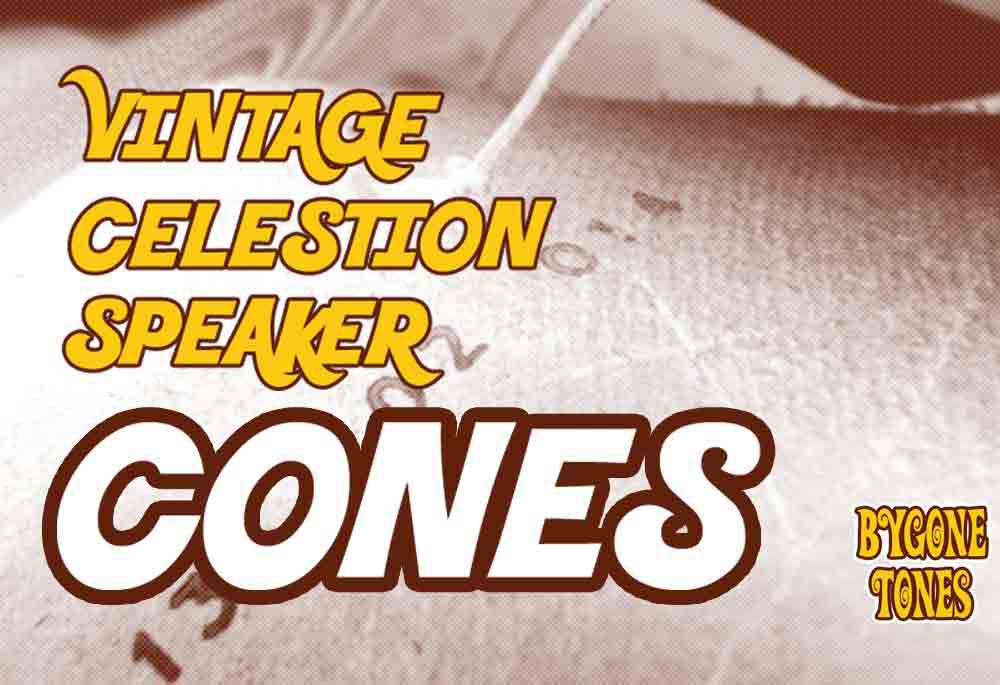
Tone Is In The Cone
Over the years Celestion have used various cones from different suppliers, all slightly different in tone.
Celestion have never really given any information out about their suppliers. Therefore a lot of the details about them that you might read elsewhere, often just turn out to be nonsense that has been repeated and passed down the grapevine over the years.
The information I have written on this page is based on my own experience dealing in vintage speakers. It may conflict with information you have picked up elsewhere, but is accurate to the best of my knowledge.
Quick links
About Recones
Pulsonic
‘Large Rib’ Pulsonic
RIC
98700
Kurt Mueller
‘Large Rib’ Kurt Mueller
Some Common Misconceptions Debunked!
The Kurt Mueller Myth
If your speaker has a ‘1777’ or ‘444’ stamp, it does not automatically mean it is a Kurt Mueller cone. These are actually Celestion part numbers and can be found on several different cone types.

Blank cones and handwritten markings
If your speaker has a hand written code, or is completely unstamped, this does not automatically mean it has been reconed. If it looks original and sounds original – it is probably original.
The ‘RIC’ cones from the mid 1970’s are particularly common to find with either a yellow chalk marking, or no marking at all.
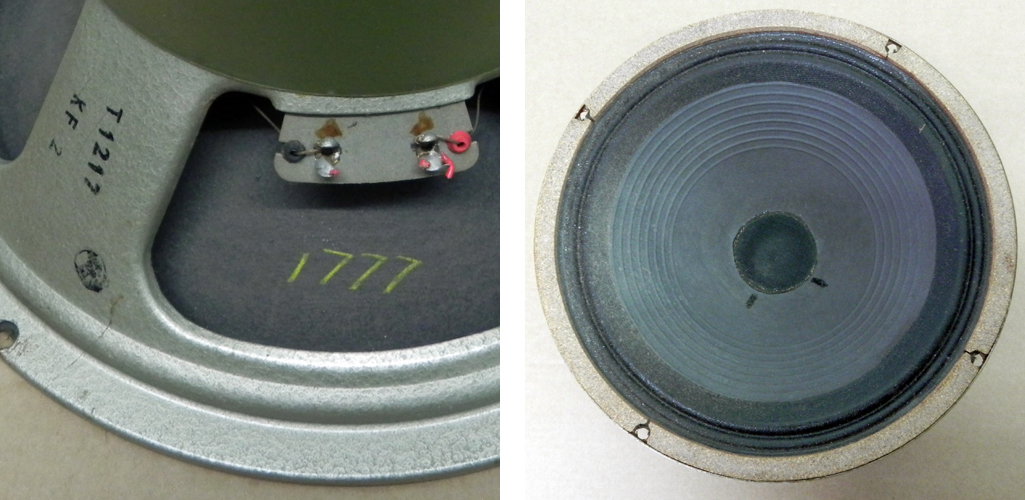
About Recones
Old recones are usually fairly easy to spot because they will look a lot different to the original Celestion cones. Watch out for odd looking cones, over-sized or incorrect dust caps, unusual looking lead wire glue (the two black marks near the dust cap), and spider supports that overlap the frame rim or just look too new.
When reconing a speaker, the original gasket surrounds would often be re-used, especially if they have a date stamp on them. So an original gasket does not automatically mean the cone is original too. The white manilla gaskets are particularly easy to remove and re-fit.
Most speaker repair places will leave a sticker on the frame of the speaker somewhere and that is often the first visual clue.

A common recone to find on older speakers is the Waldom recone kit, which usually has the cone stamp WF***.
Recones are not the end of the world and can still sound good so long as the speaker isn’t faulty. However, any collector value goes right out the window once the original cone is gone. So never pay top dollar prices for a reconed vintage speaker.
Celestion factory recones
Celestion would sometimes print a new date stamp when reconing a speaker. This is usually accompanied by an additional ‘RW’ stamp, and can often be found on the old alnico’s from the 60’s. Obviously if it is a very old recone from when Celestion were still using pulsonic cones then this should not affect value too much and will still be a desirable speaker to most people.
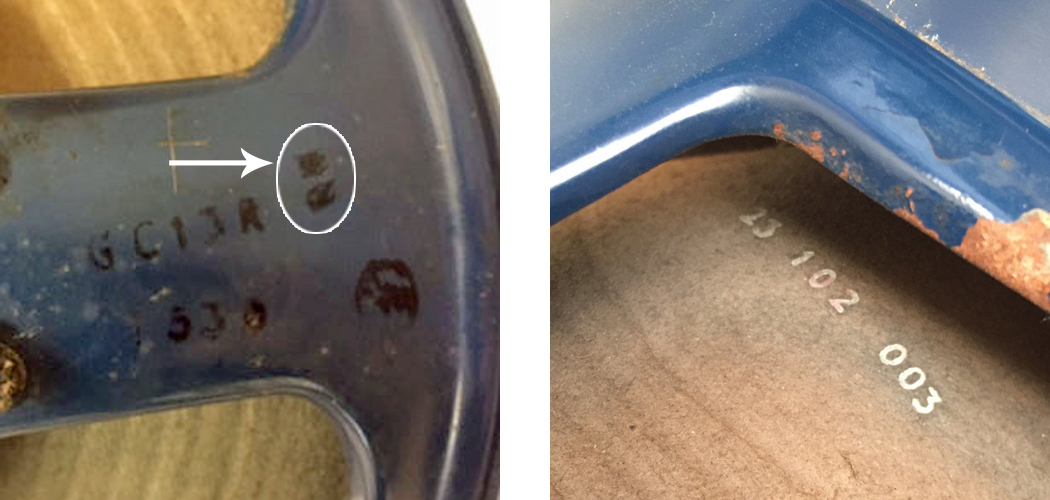
Cone Types
Shown below are some of the most commonly found cones from the 1960’s and 1970’s.
Pulsonic Cones
The pulsonic cones first appear around mid 1962, most notably on the T530 “vox blue“. They are easily the most sought after cones by guitarists because they have a superior quality to their tone that cannot be found in any other speaker cone. Their slightly softer and more ‘fluid’ sound is particularly popular with blues and classic rock guitarists.
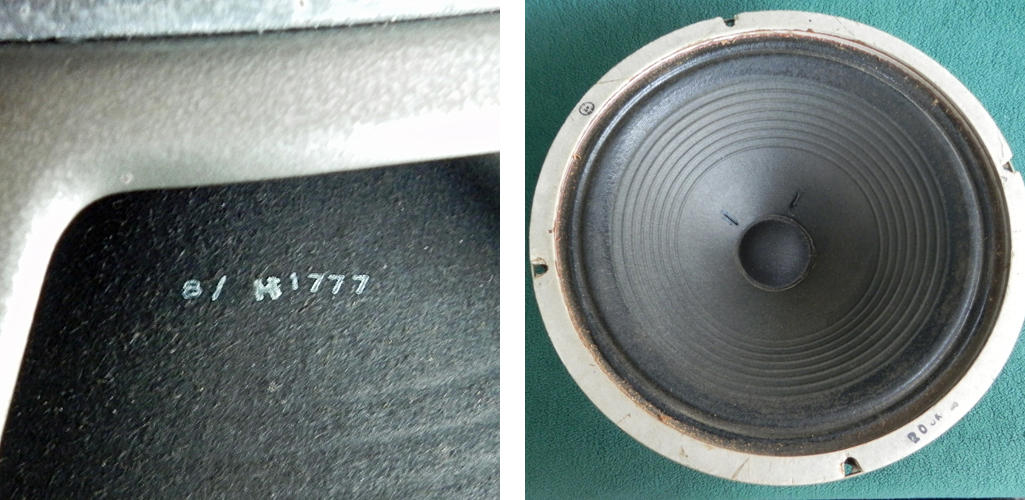
Pulsonic cones are highly collectable due to their association with the legendary guitar players of the period such as Jimi Hendrix and The Beatles, and their use in the old 60’s Marshall and Vox amplifiers.
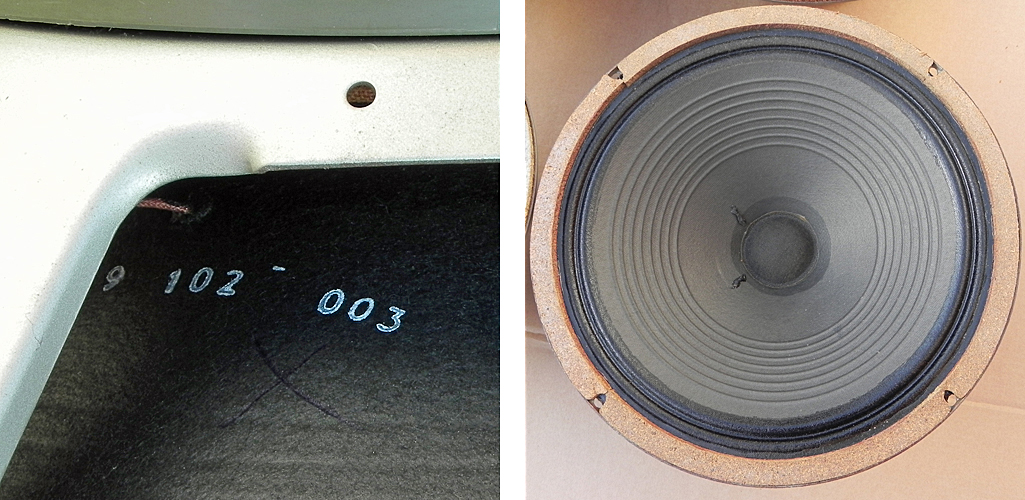
Legend has it that a fire at the Pulsonic factory in late 73 destroyed the magic formula for making those sweet sounding cones. Nobody has successfully managed to replicate them in my opinion, though several boutique brands have tried, as well as Celestion themselves with their Heritage greenback range.
There are various cone stamps to be found on pulsonic cones, largely depending on when they were made. Some stamps are less familiar than others, including the ‘1777’ stamp which people often incorrectly assume must be a Kurt Mueller.
A while ago I found an unusual T652 speaker with both the H1777 and 003 stamp on the cone. I decided to include it here as my evidence for the non-believers. Same cone, two different stamps:

Pulsonic cone stamps through the years
| 75Hz Pulsonic Stamps | 55Hz Pulsonic Stamps | ||
|---|---|---|---|
| H1777 or **/H1777 | mid 1962 to 1966 | SP444 or **/SP444 | 1966 to 1967 |
| 003 or **/003 | mid 1966 | 014 or **/014 | mid 1966 |
| **/102/003 | mid 1962 to 1967 | **/102/014 | 1966 to 1967 |
| ** 102 003 | mid 1962 to Apr 1971 | ** 102 014 | 1966 to Apr 1971 |
| 102/3 or 102 3 | Apr 1971 to Apr 1973 | 102/14 or 102 14 | Apr 1971 to Apr 1973 |
| 3 | Feb 1973 to Apr 1974 | 14 | 1972 to Apr 1973 |
| 1777 | Feb 1973 to Apr 1974 | 4 | Apr 1973 to Apr 1975 |
| 1777 (large rib) | Aug 1974 to Apr 1975 | 102/30 | Apr 1971 to Apr 1973 |
| 5 | Apr 1973 to Apr 1974 | ||
| . | 0444 (large rib) | Aug 1974 to Apr 1975 | |
| '**' = a variable two digit number said to represent the week of the year the cone was made | |||
| . | |||
| Note - dates shown are for very rough guidance only - expect transitional overlaps. | |||
‘Large Rib’ Pulsonic Cones
These cones are basically the same as the earlier pulsonic cones but have noticeably larger ‘ribs’, or ‘corrugators’ to give them their proper name. They can usually be found on creamback speakers made between mid 1974 to mid 1975.
If the fire in 73 story is true, these were possibly made from the remaining stock of pulp.
The typical cone stamps are ‘1777’ for a 75Hz cone, and ‘0444’ for a 55Hz cone – notice the leading zero.
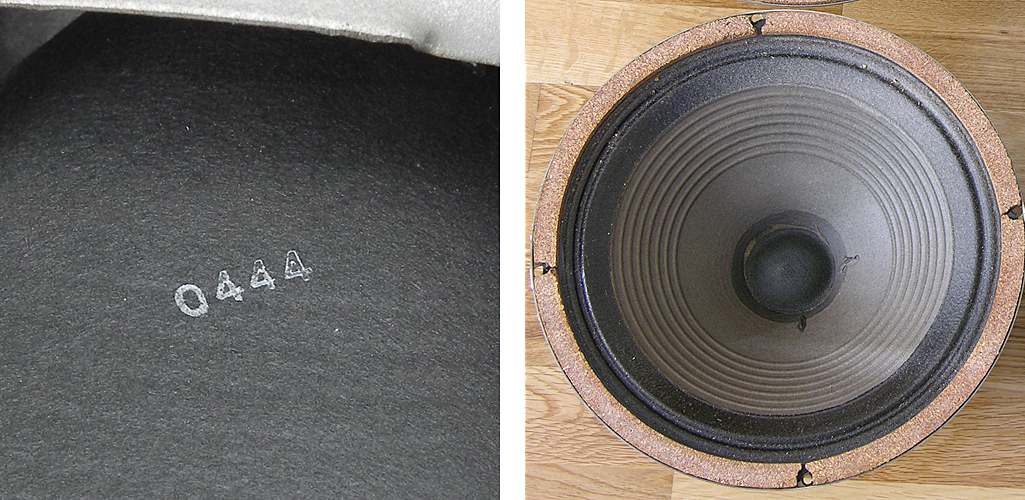
Their sound is very similar to the previously mentioned pulsonics, but you might notice they are marginally brighter at lower volume levels. The beauty of these cones is that because they were produced a little more recently they tend to turn up in better condition than the older pre-rola speakers and are usually a lot cheaper to buy!
Most people dismiss these cones as Kurt Muellers because of the cone stamps. A classic example of how a lot of guitarists use their eyes when evaluating gear, rather than their ears!
‘RIC’ stamped cones
Most commonly seen on greyback and creamback speakers from around August 1973 to mid 1975, and on most ‘G12’ alnico speakers made before mid 1962. These cones were probably made in house at Celestion’s Thames Ditton factory in my opinion.
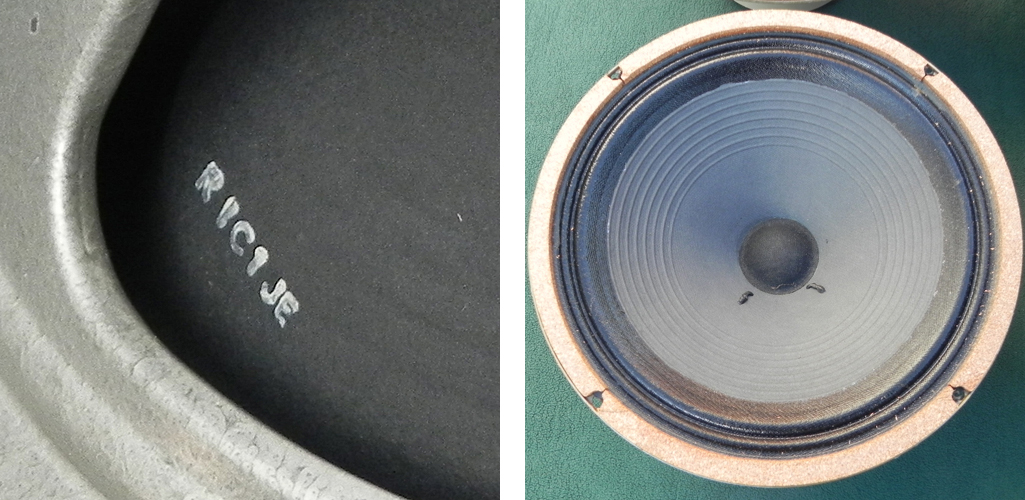
They are usually fairly easy to identify by their blue/grey appearance, and they do not usually have a ‘shadow’ around the dustcap like a pulsonic or mueller cone.
Their sound is quite distinctive, and they are generally under-rated by most people. Often described as ‘dark’ sounding which may be unfair. They are very nice sounding cones in my opinion, with a smooth sound that can tame a harsh sounding amplifier, and they can be superb for lead work, although do lack some of the sparkle found in other cones and can be a bit ‘boxy’ for rhythm playing. Try mixing with a pulsonic for the best of both worlds.
Other stamp variants found on non-greenback models include ‘NIB’, ‘ROB’ and ‘JIL’, which I am confident are cones from the same factory but made to different specifications. The NIB cone was standard on the 10″ speaker model 7442 used by Marshall all the way through from late 1960’s to mid 1970’s, and is a very highly regarded speaker amongst Marshall collectors.
Stamp variations:
It is common to find the RIC cones without any stamps or other markings, particularly around early 1974. So be careful not to dismiss them as recones. I have definitely owned more without stamps than with.
Another variation is a handwritten 1777, 1444 or 444 in yellow chalk. Again, these are not recones, and are fairly common for late 73/ early 74.
98700 cones
These are very rare cones and were only used for a short period. They can usually be found on creamback speakers made between May and July 1974 – with date stamps EG, FG, or GG.
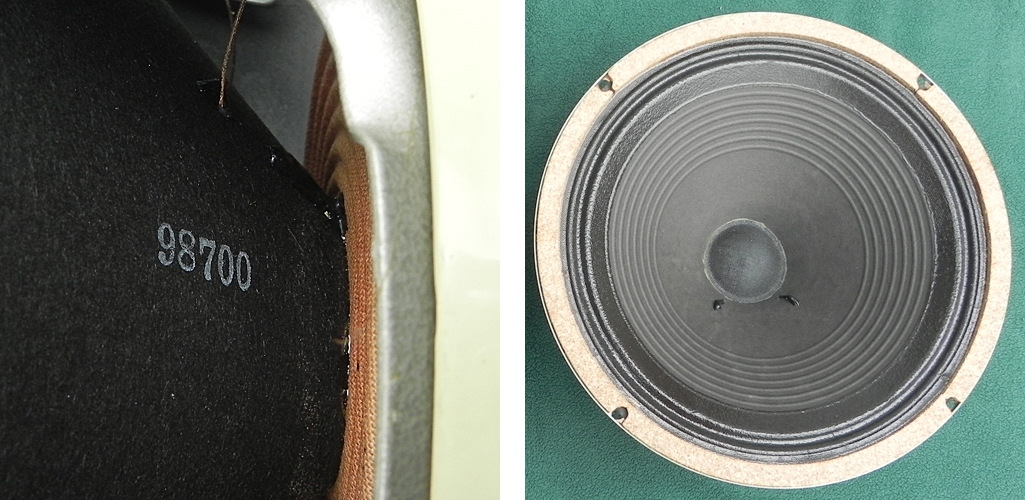
Very little is known about them, but I can tell you they are some of the nicest cones you can find and are well worth looking out for. Please do not dismiss them as recones. The tone is slightly less mid focused than the pulsonics, so a bit flatter sounding, but still a very nice smooth & fluid tone, not harsh or gritty.
Kurt Mueller Cones
These are the most common cone to find on the late 70’s and 80’s speakers; the ‘blackbacks’, G12-65’s and G12-80’s etc. They first appear early 1975 and were used well into the 1980’s.
Their tone is a bit more aggressive than the pulsonic cones and may be more suited to your style if you play heavy rock. They are a good sonic match to the master volume Marshall amps of the period.
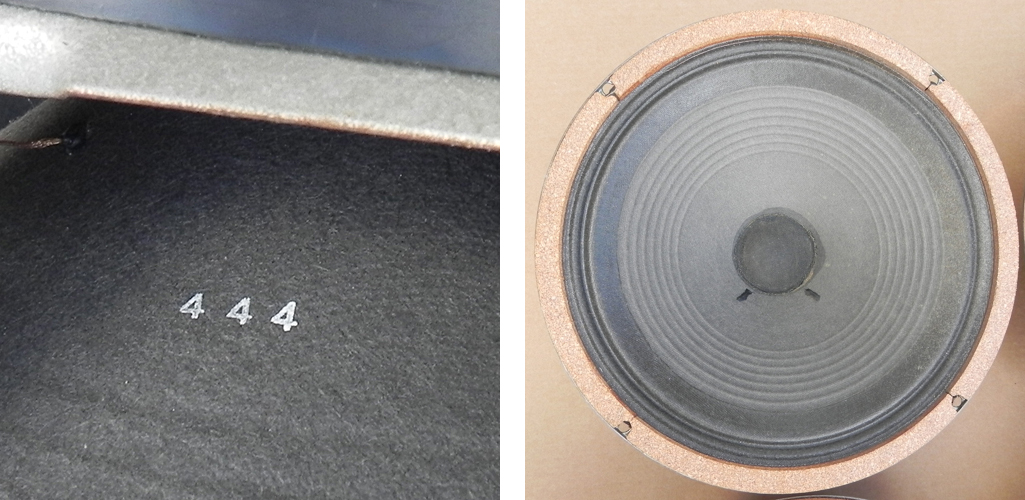
Usually stamped 1777 (75hz cone) or 444 (55hz cone), depending on the speaker model.
They tend to be pale grey in appearance wth a slight shadow around the dust cap. Although colouration does seem to vary and can appear darker or more blue in some cases – this can happen if a different dye has been used for the paper pulp.
Stamp variations:
The first Mueller cones from early 1975 are usually unstamped, or may only have a small single digit number written on them in marker or chalk, with a brown colouration to the doping.
Through mid 1975 some Muellers have their codes handwritten in black marker.
The white 1777 and 444 stamps only seem to appear on Mueller cones towards the end of 1975. Earlier 1777 stamps are unlikely to be Muellers, and are probably Pulsonic or large rib Pulsonic.
Some late 70’s and 80’s cones are stamped in black ink, and can often be difficult to see.
‘Large Rib’ Kurt Mueller Cones
These cones are a variation of Kurt Mueller in my opinion, but I could be wrong. They can be found sporadically on blackback speakers and G12-65’s made in the late 1970’s. They basically sound near enough the same as the previously mentioned Kurt Mueller cones. However at low volume they are a little bit clearer and brighter sounding to my ears, which I do prefer.
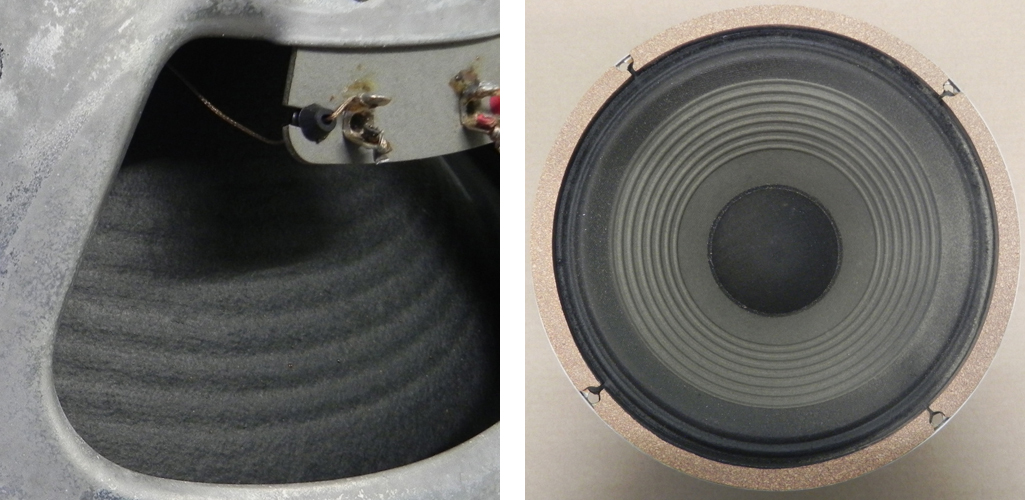
The most notable difference is the larger ribs on the cone and the lack of any cone stamp. The back of the cones are usually a lot darker in appearance.

I’d like to find out what drivers I have year etc etc
FJ18X T2168
1777 on cone
Thanks for considering
Author
Hi, FJ18 = 18th June 1976, with Kurt Mueller 75Hz cone. The ‘X’ is just a factory stamp and can be ignored. T2168 is the same as T1221 but without the plastic magnet cover, so it is basically a standard G12M greenback without the cover. More info here:
https://www.bygonetones.com/celestion-date-codes.html
https://www.bygonetones.com/celestion-speaker-models.html#T1221
https://www.bygonetones.com/celestion-cones.html#KurtMueller
Hope that helps, Brian.
I have a G12H 55Hz 30 watt Greenback
Frame #GXT 12348 123?8
Cone Number 102/01L
Can anyone give me details and where I might buy an authentic Recone Kit?
Thanks!
Author
Hi Tim, you can buy the genuine Celestion recone kits from lean business:
https://www.lean-business.co.uk/eshop/spares-celestion-12-guitar-recone-kits-c-45_46.html
regards, Brian.
Hello Brian,
I am considering to buy a Rola Celestion G12-50 speaker, it has a T2850 and a DN21 stamp (Apr.21st1980?) on the frame, a white dust cap and a 2639 stamp on the cone. Also a cork rim. Seems not to match your list, could be a recone?
Thank you,
Bert
Author
Hi Bert, I am not familiar with that one sorry. Can you send me some photos of it? I will add it to the list.
Those G12/50’s tend not to be designed for guitar as such. They are usually more of a neutral sounding speaker to be used with line-in sources. The 2638 cone is likely original, just a different specification to the usual 1777 and 444 cones of the period.
If you email Celestion themselves they should be able to tell you more about it, and what is was designed for – drdecibel@celestion.com
Hope that helps, Brian.
Hello Brian – i’ve had a speaker for 30 years unidentified and it would just be novel to know its identity though i feel its probably a Fane not a celestion. On chassis it has 1221457 and 1198 * (< * = 4 or a 1 ). It appears to have a large rib cone, 8 ohm with big magnet and the large dust cap. I just wondered if the codes gave it away to you ?.
Great site – Kind regards
Author
Hi Mark, can you email me some photos please? info@bygonetones.com It does sound like a Fane speaker to me. Most of them have the ‘122/’ prefix to the model number.
Brian.
Hi Brian thanks for your reply will do
Regards – Mark
I have 2x T1281 G12H 55 Hz greenbacks from end 73 and beginning of 74, both have RIC1 cones. Shouldn’t they have been creambacks?
Author
Hi, well end of 73 into early 74 would normally be greybacks, but you can find the green still being used into 74 yes. It is nothing to worry about. There were transitional overlaps. Also previous owners might swap them around or buy them online as spares.
Brian.
hi, i actually worked at meullers years ago for a while. the cones are made in a mesh mould 4 on a rotating machine,and the papers is poured in from a massive vat high up. there was a room full of these machines, we would churn out 1000’s per week, there was no custom, hand babying, intense criteria selection- bang ’em thru, like cheeseburgers , we are running to a timeline..if it works, and no faults- its all good. the paper pulp was just a speaker paper- what type i never saw any different type, what changed was the mesh grill and corresponding piece that pressed down. sometimes there would be 2 stuck together (rejected) but the moulds were all different. there was alot of steam, as the paper was dried out by the heated part, steam, dirt, dust.. sometimes scrap cones would be chucked back into the vat to go through the process- that was the dirtiest job you will ever have seen, climbing up there. the original moulds would be the way to get the original tone, as the thickness could vary, i sorted 1000 s out, chucked 1000’s. the experts in the field probably have original cones, they have measured, and cut through samples. thats my 002cts.. it is like the chase for period strat scratch plates, paying a fortune, or a 60’s wound pickup..
Author
Hi Jonny, interesting info, thanks for sharing.
Brian.
Do you know 1n late 74 they used a 3 underlined stamp.i have a Oct 73 g12 gryback only mark is a chalk 3 not stamp on cone. Could it be a pulsonic hand written 3 indication ? Its white chalk on leg its t1221.date code kf18 thanks
Author
Hi David, can you email me some photos of the speakers? They are most likely RIC or pulsonic cones, but I would need to see them to confirm.
Brian.
Some useful business history of C.T. Chapman/Pulsonic/Kurt Mueller here: https://find-and-update.company-information.service.gov.uk/company/00477895
Tracing the actual business history does not align with the narrative built up around this subject!
Author
Hi Jason, thanks for posting the link. I am aware of it and the factory history. John Paice was using the info to research his ‘Century Of Sound’ book. I’ve been meaning to update the page with the factory info for a while, just haven’t got around to doing it yet.
regards, Brian.
Thanks for the site and sharing this info. I have a 63-ish AC30 that has the original blues and was curious to learn more about the speakers/cones as they make all of my amps sound magical. They both are stamped RIC or R/C Rola Celestion. Even Jim Elyria’s Vox book doesn’t have much info on these cones and mostly focuses on Pulsonic and Kurt Mueller cones. Are there any vintage 10″ speakers that sound similarly smooth/dark you can recommend for an AC10?
Author
Hi Chris, fwiw I’m not convinced the RIC code represents ‘Rola Celestion’. Just because there are other cone stamps on Celestion speakers that appear to be from that same cone manufacturer. I’ve definitely seen ‘NIB’, ‘ROB’, ‘JIL’, and there are probably loads of others I haven’t come across yet. As for 10″ speakers definitely try the 7442 model ceramic speaker. This came with the NIB cone as standard all through the 1960’s and never the pulsonics. Find them mostly in Marshall gear. 10″ alnicos are more difficult to find. Elacs were a popular choice at the time but they are quite bright and chimy. Goodmans would probably give you a darker tone than the Elacs.
Hope that helps,
Brian.
I’ve been offered a pre-Rola T1221 but it has both 444 and 1777 printed on the on the cone, doesn’t seem right or does it?
Author
Hi, no those are recones. Those are late 70’s Mueller cones. Is it the pair on ebay at the moment? The doping is wrong too for 69, it would not be as broad as that.
Brian.
Hi! I have Simms Watts cab with G12H30 T1217 and EE code below and 2 06 04 on every cones. Do you have an idea what does it mean? They were reconed?
Thanks
Michał
Author
Hi Michal, yes it sounds like they are recones. You can email me some photos to confirm, but those speakers should have the 102/3 pulsonic stamps on the cones if original. The EE date stamp is May 1972.
regards, Brian
Brian,
One of my speakers have 1975 stamp on the cone, T2320 and HJ20 on chassis. White cloth dust cap. Do you have any information about this cone? Is that 75hz or 55hz?
Thanks ,
G
Author
Hi Gavrilo, T2320 is a G12/50 model, HJ20 = 20th August 1976. The 1975 stamped cone is most likely a Kurt Mueller made cone, but that’s only an ‘educated guess’ based on the year it was made. I believe it is a 75hz cone, see T2239 on my T-number list. You might want to email dr.decibel@celestion.com for confirmation, they have every speaker model on file there. regards, Brian.
Thank you Brian.
Best regards,
Gavrilo
Man, I feel so bomb. The man lives in another part of the country. I am handicapped and I bought ” blindly” though I asked him to send a picture of the quad – he sweared and signed onto the receipt that I got 4 X 12″ four (at least) greenbacks, even 2 pulsonic greenbacks
2 of them was “Vintage 30″ – the other 2, I haven’t even found what they were…
– They have a number on the cone: 1306FG1201 and on the cone 3 45 088
– The cone is about 31/2″ and curved in. I feel quite stupid, that I didn’t ask for a picture.
Nerver mind, I still have a 4 x 12” but well paid for.
Author
Hi, I feel your pain, that sucks. Sometimes it works the other way too though, you can get lucky with a nice set of speakers just because the seller was too lazy to check what was in there.
Brian.
Hi cool site. I got a 1983 g12-65 from a Proamp Viper. Proamp were based in Essex. Got the amp for 60 euro so a fresh deal. Speaker is as new. Would this be a good vintage for these? It’s the 1777 cone. Thanks
Author
Hi Pete, sorry for late reply. Yes a G12-65 from 1983 should be a really nice sounding speaker with the Kurt Mueller 1777 cone. A good vintage. However you should always check old Celestion speakers for coil rub and lifting spider supports, it is not a given that they will just be perfect speakers.
Hope that helps anyway,
Brian.
Hi Brian. Thanks for taking the time to answer. The speaker is now in a Peavey Classic 30 and it sounds the business. The Blue Marvel was a bit harsh for apartment use, the g12-65 is much more easy on the ear. Perfect match. Funnily the Blue Marvel sounds great in the 80’s solid state as a cab or using it as an amp. The speaker had coil rub for a few minutes when I cranked it the first time but it seems to have cleared up.
But I can say that a vintage Celestion g12-65 is the perfect match for a peavey classic 30.
Cheers again. Your site is a cool piece of archive work.
Author
Hi Pete, thanks glad you found the site useful, and are enjoying the G12-65. Yes sometimes speakers can have dust in the coil gap and a good loud blast can clear it!
Brian.
Hi. I’ve bought an 80’s cheap solid state amp with a ROLA Celestion. It has a magnet sticker G12/50. As per my knoledge the speaker year is 1983 and is from May, it has a stamp ER4 on the chassis leg. The model is T2967 – 8ohm. The white stamp at the cone is 2712 followed by a indecifrable white spot…does this 2712 mean anything?
Cheers
Alvaro
Author
Hi Alvaro, it is just the part number and does not really mean anything as such. Just a different specification to the usual 1777 and 444 cones. Likely made by Mueller, but I can’t say for sure.
Hope that helps anyway,
Brian
Hi Brian,
Got one of these left- a smooth cone G12-80 with date code GQ20 (07/20/82?)
And frame code T2880. And is 15 ohm Rola Celestion
Black cone is marked in black with ‘3608’-
Never seen that cone number before?
Any clues ?
Author
Hi Mark, sorry for late reply. The 3608 cone stamp just means it has a different cone specification to the usual 1777 and 444 cones of the period. GQ20 would be 20th July 1982 yes. The speakers with smooth cones are designed a little differently to guitar speakers, and don’t always sound good with guitar, especially with distortion.
Hope that helps anyway, Brian.
Thanks for your help with this speaker, Brian!
Rock on!
Mark
Dear,
I recently bought a combo amplifier which came with a G12-65. From the date stamp, I expect it to be made in 1979. So far, I can’t find a cone stamp, but I do see some logo, which you can see in the picture. Do you have any idea what it is? The front of the speaker, cone-wise, looks very much like the large rib Mueller cone you showed in the article.
https://ibb.co/XbqbK9f
Kind regards
Author
Hi Frederik, it is probably a large rib Kurt Mueller as described in the article. I can’t be 100% sure those cones are actually made by Kurt Mueller. They could be from another manufacturer, but when I compared them, they did sound very similar to the normal Kurt Mueller cones, maybe a little brighter. The little black ink squiggle you see on your cone is common on Mueller cones too.
Hope that helps, Brian.
Hello Brian,
thank you so much for all your diligent research and effort you have given us. It is most appreciated and valued to say the least. I’m being patient as I go about reorganizing my speakers and cabs, and also regret parting with my G12M25 75 hz quad of Black Backs.
Needless to say, I did buy a quad of 55 hz, but I’m selling them.
So I have recently been searching for Pre-Rolas G12M25 75 hz 102 003 & G12H30 55hz 102 014. It has been confusing to say the least, I assumed a 75 hz would be 003 not 014?
And the same with the 55 hz, not being an 003 cone?
I have found these https://reverb.com/item/35308725-quad-of-original-pre-rola-celestion-greenbacks-from-1970-g12h-t1534-pulsonic-cone-102-014-55hz-aluminium-dust-cap, but I’m unsure of the aluminum dust caps? Will they be a hinderance to the tone? will they fall off? I may have opportunities to score these speakers here in Jersey? But I want to follow up on all leads.
Thanks Again,
Jerry
Author
Hi Jerry, glad you are finding the website useful. I get asked about the 75Hz & 55Hz labels quite a lot. Basically the Celestion labels only had 55hz written on them from about 1972 onwards. Thats the Rola labels with the speaker symbol on them. Before this, and during the pre-rola period they just put 75Hz labels on everything. It’s as if they were short on labels and did not have specific labels for every speaker model they made. So some speakers shared the same label or had little stickers amending the information on them. The way to check is by the stamp on the cone – 014 for 55hz models, and 003 for 75hz models.
Model T1534 is a 55hz model speaker. So the 014 cone stamp is correct, and I would expect to see a 75Hz label on them in 1970. However, the ones in your link have clearly been repaired. Personally I would pass on those and wait for some in original condition. The silver dust caps are definitely not original. I doubt the dustcaps would fall off but you don’t know what repairs have been carried out, possibly to the voice coil, that could have a serious impact on how they sound. If he was selling them cheaply as repaired speakers then fair enough, but at that price I would pass. If you wanted to resell them in the future I think you would struggle to get even 50% of that money back. They are only worth premium prices in perfect 100% original condition in my opinion.
Hope that helps,
Brian
Hi Brian,
thank you so much. Not only will I steer clear of them, but the seller as well.
Author
Hi Jerry, in fairness he does mention they have been repaired, lower down in the description after all the holy grail spiel. The asking price does not reflect that though in my opinion. I’ve seen worse from other sellers on reverb. Recones described as original etc. Fwiw the silver dust cap model used by Laney was the T1976 model. They also used Goodmans with silver caps.
Brian.
Hey Brian
Can a stamp on a 1217 have a stamp: 58/ 103 or 59/ 103. One of the cones has something spilled onto it, but the Price is £255 plus delevery to Denmark. Is it too cheep?
Regards Steffen
Author
Hi Steffen, yes it’s possible, what year are they? Value-wise it really depends on how they sound, not what they look like.
Brian.
Brian, 1973
Author
Hi, that sounds a bit unusual actually, do you have a link to the listing? Or some photos of it? If the date stamp is ‘EF’ with no numbers in in it, then that is a common back to front date stamp for June 1972.
Brian.
Hi Brian
Thanks for the swift reply; it was sold, but I found another that looks without fraud. I’m tying to collect a quad.
I have a question for the cone number collection. A Rola produced “Marshall” labelled 12″ H-100, 8 ohm with white cone number: 1230. It was in a 65/66 JMP 2150 combo. I’m not gonna buy it because I go for 16 ohms, but considering your cone number collection, I wonder if it can be valuable as information.
Best regards
Steffen, Denmark
Author
Hi Steffan, can you email me a link to the listing or some photos please? Sounds interesting.
Thanks, Brian.
Hi Brian
I am not sure you got the link to the Rola produced Marshall H-100; here I send it again:
https://www.ebay.co.uk/itm/Rola-Celestion-G12H-100-Powercel-12-Gitarren-Lautsprecher-Marshall-Combo-60-70/184415502640?_trkparms=aid%3D111001%26algo%3DREC.SEED%26ao%3D1%26asc%3D225076%26meid%3Ddeea5fb1efde4d13be3bec58e30ec4f2%26pid%3D100675%26rk%3D6%26rkt%3D15%26mehot%3Dnone%26sd%3D133451044015%26itm%3D184415502640%26pmt%3D1%26noa%3D1%26pg%3D2380057%26brand%3DMarshall&_trksid=p2380057.c100675.m4236&_trkparms=pageci%3Ad44bfac3-f51c-11ea-897e-74dbd180fa53%7Cparentrq%3A8358e6f11740aca475159a56ffffe286%7Ciid%3A1
A long link, sorry. But I don’t have capacity to download and send pictures.
Best regards Steffen
Author
Hi Steffan, this looks like a Goodmans speaker to me rather than a Celestion. Very unusual. Maybe the label has been transferred from a different speaker?
Brian.
I think you’re right, Brian. I found a 12″ 8 ohm, 50 watt Goodmans speaker on a Danish (dba.dk) website. It says Selmer on “hood” 1964 stamp I found was 23 1 on the corks (not it’s the right word) the edge / frame around the inside.
But the “bay” said it was on a Marshall combo, well what do I know. I am in a learning process.
It was maybe worth it, uf it had turned up to be pulsonic.
Take care
Steffen
Hi Brian
Last question for now! G12H30 T1217, Jan ’74. Graybacks, grey inside cone with small ribbles; grey coloured on outside of cone. No stamp on any. Very clear tone though more boomy than a M. I have heard a RIC cone, this less treble.
I have played them next to 2 x 12M25 T1221 pulsonic, aside from the sound on E&A strings they sound alike.
Is reasonable to assume that stock of pulsonic cones were left in Jan74? Seller verified original cone very still on (they look used and aged but good condition)
I’m done buying for now and won’t haress you for a while, Brain 🎸
Author
Hi Steffen, Jan 74 with no cone stamp is almost certainly a RIC cone, but I would need to see photos of them to confirm. If you want to email me some – info@bygonetones.com They can sound different when compared just due to the ageing process.
regards, Brian.
G12/50 Blackback Cone stamp “1975”
Is this speaker from the year 1975 or what’s up with this cone? It sure looks original!
Author
Hi Anders, the 1975 cone stamp was standard on some Celestion speaker models, it is not a date stamp. If you look at the T-number list you will find a few G12/50 and G12/50M with that stamp. Just a different specification than the usual 1777 and 444 guitar cones. Hope that helps, Brian.
Hi Brian, thanks for the amazing resource you have put together with this site. I have a ’75 Marshall 1935A which has a quad of cream-back T1511s. Two are dated GH12X and two are AH20X. Of the four, three have unstamped cones, so I’m assuming are RICs, while the fourth (one of the AH20X’s) has a “102 014” stamp. The two AH20X drivers sound a lot like the Pulsonic-coned G12M25s I’ve got, while the two GH12Xs sound much closer to the Kurt Mueller’s I own.
The question is: could it be that the two AH20X stamped drivers have Pulsonic cones, even though only one of them has a stamp?
The seller told me he thought the cone with the 102 014 stamp must be a recone but I don’t see any evidence of that, including the fact it sounds so similar to the other driver in the same cab with the same date code. Furthermore the stamp has the Pulsonic format and so surely wouldn’t be a replacement cone from post-’75 when the speaker was originally made.
Any thoughts would be great, thanks in advance!
Author
Hi Adam, assuming they are original cones, then the two unstamped GH12X are most likely going to be Kurt Mueller’s in 75. The first Mueller cones were unstamped like that through 1975 from what I have seen, so that is normal. As for the other two AH speakers they do sound a bit odd to me. The 102 104 cone is definitely unusual for 1975 and the unstamped pulsonic would also be unusual. I would be interested to see some photos of that pair if you can email me some info@bygonetones.com It’s possible they are old recones but you do get oddball speakers from time to time too. I once saw someone selling a late 1975 creamback with a ‘3’ stamped pulsonic cone that looked all original. It’s possible they are old Celestion recones but unless Celestion marked them as a recone it would be very difficult to differentiate them. How was the wiring in the cab? Did the solder joints look original? Did the speakers come out of the cab easily or were they stuck to the baffle? Little clues like that can tell you if the speakers have been messed about with in the past.
Brian.
Hi Brian, That’s great info to have, and I’m relieved to see my ears weren’t deceiving me about that pair that sound distinctly “KM”-y! I’ll open up the cab again and send photos and further information to you at your email. As far as I remember the wiring all looked pretty original.
Is it possible that black back T1221 speakers from a lovely sounding 1975 Marshall 2045 cabinet might have Pulsonic cones?
Author
Hi Rick, yes it’s possible, send me the photos if you can. info@bygonetones.com
thanks, Brian.
Photo’s sent. 🙂
Hi Brian. Got an old 12” Vox speaker with 102 003 stamp. Pulled it ages ago from an old Wem Dominator. Don’t know much about it’s history. Sounds very nice and is in great condition.
Any idea about it’s origin and value?
Thank you
Max
Author
Hi Max, can you email me some photos please? info@bygonetones.com
thanks, Brian
hi Brian, what a great article, I need your help ! I have a basket weave from1969 with G12M : all the speaker frames say T1211 CB31 BUT the cones ” 63 H1777 ” and not ” 102 003″ !!! I dont understand how that can be? are they recones or left over cones from 63 put in 1969 frames ?
here are pictures
https://i.postimg.cc/1zBrRSJN/IMG-8960.jpg
https://i.postimg.cc/FRKg76BC/IMG-8964.jpg
Author
Hi, from what I can see those appear to be recones unfortunately. I think the stamp is actually ’53 H1777′ just the ink has smudged a bit making it look like a 63. Those cones are the standard Celestion cones used on the G12M greenback and G12H ’30th anniversary’, from about the late 90’s to present day.
Hope that helps, Brian.
thank you so much Brian, you are most definitely the god of Celestion Knowledge ! much appreciated !
Hi, thank you very much for this iste, is fantastic and well done.. let me please ask for a clarification: how can the 102/30 Pulsonic cone (from Apr 1971 to Apr 1973) be a 55hz one while in the same period the 102/3 was the 75hz ? are you sure? sorry if Im asking but it seem odd to me… Thank You very much
Author
Hi Tony, 102/3 and 102/30 are different cone specifications. The 102/30 usually comes with the 4 ridge spider support, which as I understand it, is more for bass. Most commonly found on the T1886 model in Marshall Artise combo’s. They are usually labelled as 55Hz speakers. If you look at my page about the greenback models, you will find some examples. https://www.bygonetones.com/vintage-celestion-greenback-models.html#T1886
Hope that helps, Brian.
I have what appears to be a August 1972 Greenback. 16 ohms 75hz.
I was told it was reconed. The cone has WF1009 in large white ink.
It sounds fine and has no coil rib, but I have no time to reference it with. It’s my only Greenback.
What can you tell me about the cone and tone compared to the original 72?
Author
Hi Kai, yes that’s a ‘Waldom’ recone. To be honest most people don’t seem to like them. I had one a few years back myself and I remember it sounded kind of tinny and metallic. If you can find one with an original cone, it should sound a lot better. Or even just having it reconed again with a modern genuine Celestion greenback cone should improve it somewhat.
Hope that helps, Brian.
Hi,
Do you know if 15″ greenback speakers such as this one below have the pulsonic cone?
https://reverb.com/item/40656339-celestion-greenback-15-bass-speaker-16-ohms-50-watts-1970-marshall-orange-laney?utm_campaign=affiliate_embed&utm_source=js_embed
Cheers
Author
Hi, sorry for the late reply. My knowledge of 15″ speakers is not very good, but if they do not have a white cone stamp on them I would say they are most likely not pulsonic, unless your ears tell you differently.
Brian.
Hey,
Love the site, use it as a reference all the time. Got a bit of an odd one for ya – I just bought a cab with 2 1969 G12M’s in it. Both have 3012B16W4 stamped on the cones. Can’t find much info online except a couple of old listing for Jensen speakers with that on the cone. Any clue what happened here? Re-coned with Jensen-made cones?
Author
Hi Ben, recones for sure. I am not familiar with that cone code, but looking around on google, you are probably right about them being Jensen cones.
regards, Brian.
Hi Brian, I have a GJ5 T1281 with what I think is an interesting looking 444 cone stamp. Have you seen any that look like this?
https://i.postimg.cc/jsGvczJy/IMG-0449.jpg
Author
Hi Frankie, maybe just the ink was running out? What does the rest of the speaker look like? If it all looks original then it is not something I would worry too much about.
Brian.
It’s all original, I just thought the stamp looked interesting. I don’t believe I’ve had any others that look quite like this stamp.
I have a G12M 20W 15 ohm T1221 date code 12AA [12 Jan 1968] with the cone marked 417 102 003. I don’t see how the ‘417’ could be a week code, unless it means week 41 of 1967, which is plausible.
It has been in my possession since around 1974.
Author
Hi Don, can you send me some photos please? info@bygonetones.com. A 3 digit number would be unusual. Could it just be 41 / 102 003 just printed a bit funny? I have seen numbers higher than 52 though, so not sure if the week of the year thing is entirely true.
Brian.
I found a 1978 Creamback with RIC cone. Any ideas how thats real?
Author
Hi Tobi, this probably explains it:
https://www.bygonetones.com/back-to-front-celestion-date-codes.html
Let me guess, the “month” code is a letter ‘G’ or a ‘H’, correct?
Brian.
any known examples of blackbacks with pulsonic cones?
Author
Hi James, the black magnet covers first appear around April 75. At that time you might find them with the large rib pulsonic cones. With the 1777 or 0444 stamp. You are unlikely to see a blackback with the earlier style of pulsonic cone with the 3 or 003 stamp, those were phased out toward the end of 73. There are always oddball speakers knocking about though. A few years ago, I did see a late 1975 creamback with a pulsonic 3 cone. Brian.
Hello Brian
Got an Engl 4×12 pro cab with 4x Celestion vintage 30s
All 4 have the same manufacture date sticker 50HG27, but sound drastically different, visually they all look the same with clear dust caps but the cone codes are all different I somewhat recognise Z07-444 and Z37-444 haven’t seen the 444 before though usually the 0444 . Don’t know what’s with these codes on the other 2 a 6A -0444 and the other 4A-0444 what are these , any information you could provide would be great
Author
Hi Steve, that sounds odd that they would sound “drastically different”. I suspect it’s just Celestion using different cone suppliers, but could some of them be recones? Modern speakers like vintage 30’s are not really my area of knowledge, I would ask drdecibel@celestion.com for clarification, or failing that there is a guy on youtube with a ridiculous collection of vintage 30’s that might know the answer: https://www.youtube.com/watch?v=JGF-q9WoW-4
Brian.
Hi Brian,
I’m wondering if I have something of a unique. I have a lead and bass 20 combo and the 10″ speakers in it (7442) are a bit out of the ordinary. I’ve only seen these speakers with the “NIB” cones however I just realized mine have cones stamped “8378” – the ink looks similar to that of a pulsonic and these are of the right time/era but I cannot find any examples or mention of this cone code. Any insights?
Author
Hi Nick, yes the NIB cones were no longer used after 1975. They would have been made in house at the Thames Ditton factory (same as the RIC cones), and Celestion left there in 1975 leaving the cone making equipment behind. The 8378 cones are normal on the 7442 speakers post 1975 and are likely from another supplier such as Kurt Mueller, when Celestion had moved completely to Ipswich. Hope that helps, Brian.
hello Brian;
EXCELLENT site and research. I have a pair of 90s era greenbacks with cone markings 6402… and possibly 1 or 2 other characters that are hard to make out. are these original cones ?
your insight is appreciated.
thanks!
jerry
Author
Hi Jerry, glad you are finding the website useful. Yes those are original cones, the 6402 were standard through the 1990’s.
regards, Brian.
Hi there. I have several old celestions. Love them. Alnico in my ac30 and ceramic in my 4/12s. I somehow managed to hurt a 66 heavy mag speaker in a 2-12 combo. Can it be reconed if it’s rubbing or is it a waste of time and the party is over? If there is a similar cone available, where would I find it. Thanks so much. Mark.
Author
Hi Mark, what is your location? They can usually be saved without needing to recone, but depends what the problem is. Sometimes they just need carefully dismantling and cleaning internally. Torn cones are usually worth repairing rather than reconing, even really big tears. You won’t find a modern recone that is an exact match to a vintage pulsonic in my opinion. I know a repair guy in London UK, but that’s not much use if you’re in USA. You could try Chris Merren in US http://merrenaudio.com/speaker_repair. regards, Brian.
Thank you so much for this. I’m considering trying out some vintage 55hz G12H’s to replace or augment some Heritage reissues and I’m trying to see if I can find a guide to help figure out speakers’ conditions or to just get a second set of eyes on listings. Does anyone have any pointers?
Author
Hi Mike, the information on this page should be useful:
https://www.bygonetones.com/how-to-test-a-vintage-celestion-greenback-speaker.html
The most common problem in my experience is the spider support coming off. Unless the speakers have been well looked after over the years, they are likely to have this problem. Then check for coil rub and any other issues. It’s all explained on that page, with some videos to help.
regards, Brian.
Hi Brian, it’s a beautiful side!!
May I ask a question regarding a 1962 T530 speaker?
The date code is 05KG. The code on the cone is as follows: 65- H1777
I have seen cone codes like you wrote here ** / H1777 and without like this ** H1777. Do you think something like “65- H1777” (with this little minus) is original from 1962?
Thank you very much for your help!
Best regards
Marc
Author
Hi Marc, yes likely original, I wouldn’t worry about the minus symbol not being present in my article. I haven’t gone to that level of detail. Although the ’65’ is interesting as it’s supposed to represent the week of the year. Those high numbered ones could be old recone kits, but that’s just me speculating, they might have left the factory that way.
Brian.
Hi Brian, thank you very much for your very appreciated information! Have a good weekend Marc
I had one like that. 07LG date code. Sold it on Reverb awhile back. Here’s the link, may or may not work: https://reverb.com/item/38172036-celestion-t530-alnico-1962-vox-blue-12-speaker
Would you be able to tell me please what cone would be in a G12M 25 that is from January 1974, it has 444 handwritten in yellow on the cone, Do you need a pic or is that enough information, I would like to know if it is pulsonic or RIC or Kurt Mueller please
Author
Hi Ian, those are likely to be RIC cones. regards, Brian.
Hi.i have question about my grey back.25 watt 75 hrtz g12M .only has chalk number 3.could you please tell me if it is a pulmonic cone.thank you
Author
Hi David, I would need to see pics of it if you can email me some – info@bygonetones.com It could be a Pulsonic or a RIC. I’m guessing it’s late 73? Could be the last of the Pulsonic stock. The RIC cones are fairly easy to identify by their appearance. The colour of them is fairly distinctive as a grey/blue colour and they don’t usually have any ‘shadow’ around the dustcap. Their sound is also fairly distinctive compared with other cone types, with less high end ‘fizz’. Brian.
Hello there, i wonder if you could help me identify a pair of speakers i have please? They appear to be Celestion Greenbacks but they carry HH labels and are marked as HH Model 12H. They are rated at 35Watts and at 8 Ohm They both have the markings T1460 on the chassis, then one has LE29V and the other LE14V. Both cones have the markings 1.0.2./1.4. Any info would be appreciated. I could also send photo’s if that would help to identify them. Many thanks in advance for any help you can give. Kind Regards, Andy.
Author
Hi Andy, yes those are G12H T1460 model. 55Hz 8 Ohm, with Pulsonic cone. HH rated them at 5w more for some reason. The date code ‘LE’ is Nov 1972. Quite a sought after speaker model. https://www.bygonetones.com/vintage-celestion-greenback-models.html#T1281
Hope that helps, Brian.
Thank you Brian for the reply. I think the fact that they carried the HH labels and the different power rating was the main cause of my confusion with these. So am i right in assuming Celestion made speakers under licence for other Brands to market as their own? Thanks once again for sharing your knowledge. Andy.
Author
Hi, yes it was common in the 70’s for brands to have their own labels to go over the original Celestion labels. Marshall, Orange, TVM to name a few. Usually when the speakers are visible inside open back combos, such as the IC100. It is possible to remove HH labels with white spirit revealing the Celestion label underneath, but it must be done very carefully with a very small brush, and it is tedious work. White spirit will stain the green magnet cover permanently if you are messy with it, and the label will tear if you are impatient. Maybe an hours work or more for two speakers. Brian.
Hi Brian
Author
Hi
Hello Brian
I own an old Celestion Greenback,that’s probably reconed.
Frame code T1234,GD22X
Conecode 53H1777
Greats Jochem Jonker,Arnhem
Author
Hi Jochem, yes that’s a modern greenback cone in a 1971 speaker.
Hope that helps,
Brian.
Hello Mr Brian
You are the specialist for the Celestion guitar amp speakers so I would ask you one thing…Old Kelly guitar amp manufactures…are they some possibility’s bought speakers from Celestion company and putted own company’s seal paper on it?have you ever seen like this?or ever heard?
Just because someone want to sell “Kelly 12” 100W speaker(Celestion ) sealed Kelly paper on it! …writing like this?? Is this(…..) could be true??possible??
If you know anything please let me know.
Thank You.
Nobuyasu Yamagata
P.S. Thanks for the last time you gave me a nice Pulsonic info…!
Author
Hi, can you email me some photos? info@bygonetones.com I have not seen Kelly branded Celestion speakers before myself, but it is very possible.
Brian.